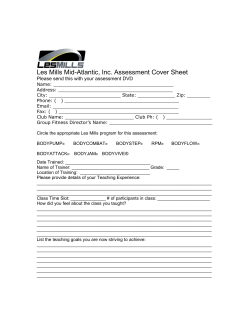
An Introduction to the Law and its Sources Susan Carter
An Introduction to the Law and its Sources Susan Carter Pepper Finance Corporation v Williams Common sense vs legal sense Common knowledge or technical knowledge Essence of common law Technical vocabulary Specialised legal terms Words with specific legal meanings and little if any use in everyday speech - ‘pure’ law terms Examples: Chose in action Chose in possession Fee simple Estoppel Codicil General terms given special legal meaning in particular contexts Words that are not ‘pure law’ terms but acquire special legal definition in particular contexts through the provisions of a statute the process of judicial interpretation Example: Competition and Consumer Act 2010 (Cth) the meaning of the word ‘goods’ is defined in section 2 of Schedule 2; ‘consumer’ is defined in section 3 of Schedule 2 Legal terms also found in everyday speech Words with related legal and general meaning Examples: land negligence nuisance assault offer agent Legal terms also found in everyday speech Words with different legal and general meaning - legal meaning is entirely different from usual English Examples: consideration equity summary (as in ‘a summary offence’) execute (as in ‘to execute a document’) title (as in ‘title to goods’) And not just English.... Latin Meaning ratio decidendi /ratio the essential reasoning for the decision of a case; the binding precedent established by the case obiter dictum / dicta an observation by a judge that is not essential to the reasoning for the decision (distinguished from the ratio) per curium ‘by the Court’ ( a proposition made by the judge) coram ‘in the presence of’ cur adv vult curia advisi vult = the court wishes to consider the matter ultra vires beyond/in excess of legal power in limine ‘on the threshold’/preliminary (used to describe an objection or pleading) semble ‘it appears’ Latin maxims Latin Meaning Volenti non fit injuria there can be no injury to the willing Caveat emptor let the buyer beware Actus no facit an act does not make reum nisi mens a person guilty unless sit rea the mind is guilty Cuis est solum eius est usque ad coelum et ad inferos ‘land’ is the surface and everything under it to the centre of the earth and everything above it to the heavens Legal sense v ‘Common sense’ Pepper Finance Corporation v Williams [2008] NSWSC 4 Law v Politics “Judges are bound by legal texts and their own prior precedents to a degree that political actors are not. And crucially, judges have an obligation to explain their results as the product of legal judgement.” Michael C. Dorf To remember: Law is both a body of knowledge and a way of thinking about that knowledge: it is important to master both. You are expected to know not just what the law is, but why. Anytime you think about the answer to a legal question – ask yourself, why do I know that this is the answer? What is my legal source or authority? You may disagree with some or indeed all of the substantive law which you are studying. But you cannot change it simply by disagreeing with it. If you want to change the law – that is turn your policy into law – you need to understand the law and its processes first. Law v Policy “Courts and judges are not meant to have agendas, and judges are not meant to seek popularity. They are expected to administer justice according to law, regardless of the consequences for their approval ratings. A judicial decision that pleases one side or the other of a partisan conflict will always attract applause or blame from some of the partisans, but people expect judges to attend to the task of administering justice and to leave politics to politicians.” Gleeson CJ Law v Politics “Behind the legal issues that the Court must decide there often are intensely political concerns. Yet the Court is expected to resolve those issues according to law, and adhering to legal methodology. We expect judges to decide issues after hearing argument in specific cases.” Gleeson CJ Legal approach v personal opinion “In Australia, one of the responsibilities of the High Court is to decide the constitutional validity of federal or State legislation. The public would be outraged if the Justices advanced, as a reason for holding legislation to be valid or invalid, their approval or disapproval of the policy of the legislation.” Gleeson CJ Latham CJ, First Uniform Tax case "[T]he controversy before the Court is a legal controversy, not a political controversy. It is not for this or any court to prescribe policy or to seek to give effect to any views or opinions upon policy. We have nothing to do with the wisdom or expediency of legislation. Such questions are for Parliaments and the people ... The Court must consider and deal with ... [the] legal contention. But the Court is not authorized to consider whether the Acts are fair and just as between States - whether some States are being forced, by a political combination against them, to pay an undue share of Commonwealth expenditure or to provide money which other States ought fairly to provide. These are arguments to be used in Parliament and before the people. They raise questions of policy which it is not for the Court to determine or even to consider." Statute Law and Case Law Sources of law • Statute –laws made by Parliament • Case law – laws made by judges Statutes v Case law Statutes operate from the general to the particular, whereas cases operate from the particular to the general. CITATION OF STATUTES • Statutes are always cited: Title/Year/(Jurisdiction) • Australian Sports Drug Agency Act 1990 (Cth) • Exotic Diseases of Animals Act 1993 (WA) s6 • Methodist Church of Samoa in Australia Property Trust Act 1998 (NSW) s4(2)(d) STRUCTURE OF AN ACT • • • • • NUMBER DATE LONG TITLE SHORT TITLE PREAMBLE (OR PURPOSE CLAUSES INSTEAD OF A PREAMBLE) • Preamble always starts with “Whereas” • TABLE OF CONTENTS • PARTS OR CHAPTERS, DIVISIONS AND HEADINGS SYDNEY TURF CLUB ACT 1943 As at 13 November 2007 Act 22 of 1943 TABLE OF PROVISIONS Long Title An Act to constitute and incorporate a Sydney Turf Club and to declare its objects, functions and powers; to provide for the acquisition by that club of certain racecourses and the equipment thereof; to provide for the discontinuance of the licences of certain racecourses; to provide for the establishment of a Racing Compensation Fund in the Treasury; to amend the Gaming and Betting Act 1912 and certain other Acts; and for purposes connected therewith. PART 1 - PRELIMINARY 1 Name of Act and commencement (1) This Act may be cited as the Sydney Turf Club Act 1943 . (2) This Act shall commence on a day to be appointed by the Governor and notified by proclamation published in the Gazette. (Repealed) 3. Definitions 3A. Notes PART 2 - SYDNEY TURF CLUB Division 1 - Incorporation and constitution 4. Constitution etc 5. Application of income etc 6. First members, directors and auditors 2. Division 2 - Objects, functions and powers 7. Objects and functions of Club 8. Acting secretary Division 3 - Financial 9. Temporary accommodation 10. Power to borrow 11. Insurance, and payments out of funds Division 4 - (Repealed) None PART 3 - RACING COMPENSATION FUND 15-18. (Repealed) PART 4 - GENERAL 19. Members defaulting in payment of bets not eligible to continue as members 20. Rights of member personal 21. By-laws 22. Commencement of by-laws 23. Public notification of by-laws 24. Offences etc 25. Exclusion of undesirable persons 26. Directors may fix tolls and charges 27. Power to let lands, buildings or tolls 28. Inspection 29. Club to repair etc 30. Indemnity 31. (Repealed) 32. Regulations SCHEDULE 1 Schedule 2 (Repealed) SCHEDULE 3 Three good sites for finding legislation: http://www.comlaw.gov.au http://www.austlii.edu.au www.legislation.nsw.gov.au The Section is the most important part of an Act Sections are sub-divided into: SECTION SUB-SECTION PARAGRAPH SUB-PARAGRAPH s1 (2) (a) (v) Australian Consumer Law - s18 Misleading or deceptive conduct (1) A person shall not, in trade or commerce, engage in conduct that is misleading or deceptive or is likely to mislead or deceive. Elements of s18(1) • Person • Trade or commerce • Engage in conduct • Misleading or deceptive Case law Decision: relevant only to the parties Ratio decidendi : reason for decision : this answers the legal question for decision : creates the binding law CASE CITATION Plaintiff’s Name v Defendant’s Name (Civil case) OR R v Person charged with offence/Defendant or Accused (Criminal case) THEN • YEAR in which the case was decided (in square or round brackets depending on the reporting system used) • VOLUME in which the case has been reported • ABBREVIATION of the particular report • PAGE NUMBER at which the report begins, and • PAGE NUMBER from which you are quoting (and name of judge) Examples: • Behrens v Bertram Mills Circus Ltd [1957] 2QB 1 • Australian Broadcasting Corporation v Lenah Game Meats Pty Ltd (2002) 208 CLR 199 • R v Brown [1994] 1 AC 212
© Copyright 2025





















